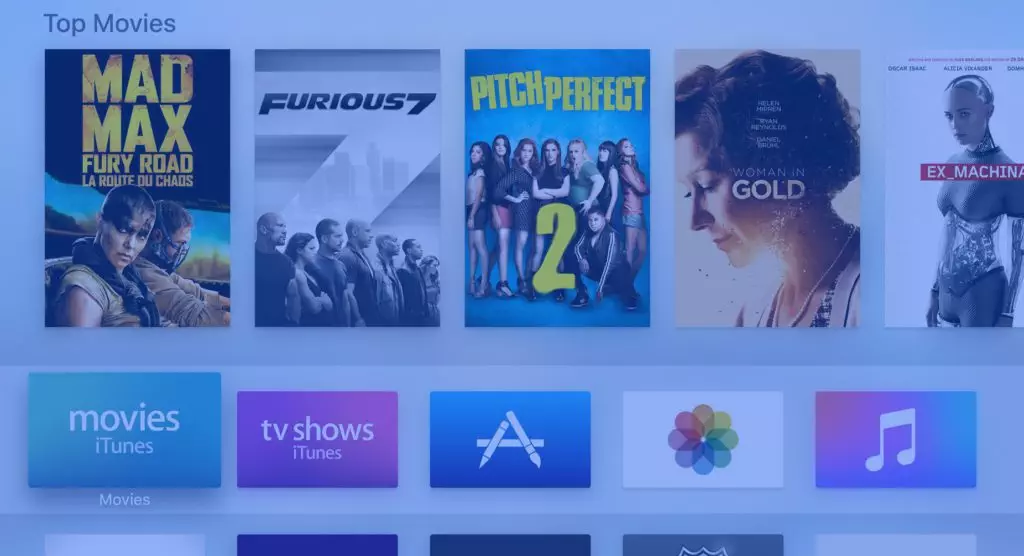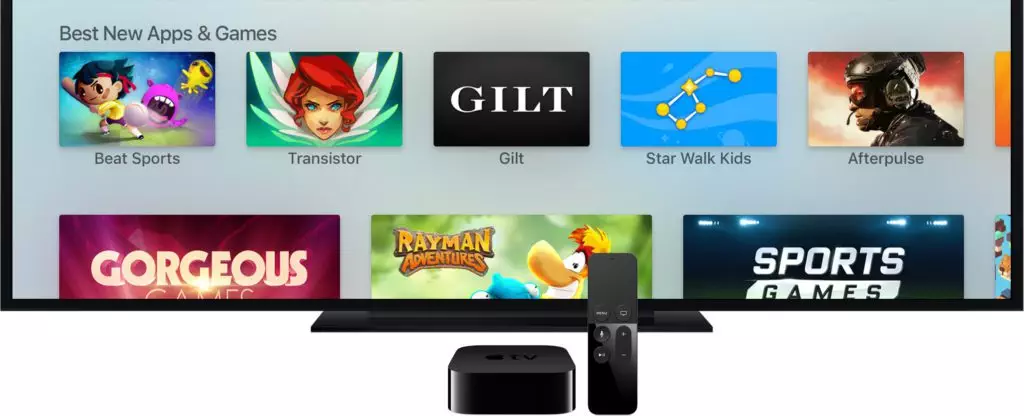
Apple TV Tech Talk Report and The Future of TV

The Future of TV
Yesterday, our Jackrabbit team attended the Apple TV Tech Talk here in Austin. It was a packed day covering everything from TV interface design to the new Siri remote to App Store distribution and marketing. The Apple experts Alan Schaffer, Mike Stern, and Josh Tidsbury presented the new platform all the way down to the nitty gritty. We took a lot of notes.
“TV is something that everyone understands, that’s why there’s such an opportunity here.” — Allan Schaffer

What you need to know
Always Connected and On-Demand Resources
One of the unique aspects of TV as a platform is that you can (almost) always assume that it will be stationary and connected to stable Wi-Fi. That’s a big difference to traditional iOS app design, where connectivity is a major consideration, from offline situations, to intermittent connections and unreliable speeds.
Therefore, assuming your content should always be available, Apple suggests your tvOS apps should come prepacked with very little in the binary bundle, and rely on on-demand resources to be downloaded as needed by the user. In fact, binaries are limited to 200 MB, while total on-demand resources can allow up to 20 GB (yea, HD video can be huge). This is done by using a tagging system to indicate when and in what order resources should be downloaded in. For example, in a game you’d indicate assets for Onboarding and Level Selection screens must be downloaded before the app could be opened, and then you’d indicate Level One assets should be downloaded first, followed by Level Two assets.

Group interactions and multi-user
Another way that the TV environment differs from our usual iOS expectations is that it’s very common to have more than one person using the system at once. Imagine a family watching a movie together, or a group of friends huddled around the tube. In iOS, it’s straightforward that each device has one user that maps to one profile and their associated account data. But in group scenarios, how do you choose who’s the user? Which account do you sign in with?
Therefore you need to think about your user model. Apple suggest to be very clear on which user profile is active at the time, showing off screenshots with big text “Kristin’s Wishlist” or “Steve’s Shopping Cart”, and prominent profile switching options.
The upside is that this aspect of a group audience creates new use cases and opportunities that aren’t common to the phone and tablet platforms.
Design: Connected, Clear, Immersive
Since iOS 7, the new design trends from Apple lean towards flat and minimal user interfaces. Apple TV looks to take that a step further with the focus-driven UI and direct interaction models. Apple’s mantra here is that TV design should be “Connected, Clear, Immersive”.
They talked about focus-driven interfaces. Since users will be interacting from a distance and using the Siri remote or game controller, interactions should be modeled to focus on one element at a time, and move the a focus indicator or invisible cursor around the screen. Further, users should be interacting directly with the content itself.

The old adage that “no UI is the best UI” looks to be even more relevant on the TV platform. For example, scrolling through a list of movies on iTunes TV, selected items animate larger and gain a drop shadow as if they’re being raised up, a title label appears, and a subtle 3D effect shows. The 3D effect orients the item as you playfully tilt the Siri remote. It does give a pretty snazzy connected feeling.
Along with the size indicators for selections, and subtle 3D effects, it looks like parallax effects are also being heavily used, to convey a perception of depth.
Input and the Siri Remote
More new devices to the Apple ecosystem for use with Apple TV are the Siri remote and game controllers. The Siri remote mimics your typical TV remote, with the addition of a touch pad, and the game controllers mimic those of an Xbox or PlayStation, so user controls should be easily adopted.
The Siri remote, along with the touchpad, has buttons for Menu, Display, Siri, Play/Pause, and Volume Up and Down. The Menu and Play/Pause buttons are programmable in an app, and Play/Pause is used as a shortcut, or secondary action, in many of the native menus. Such as on the home screen, a tap will launch you into an app, while hitting Play/Pause may resume your last position.
It should be noted that the touchpad does not support multi-touch, such as pinch to zoom. Although it does support single touch drawing, such as drawing out a letter with a finger. It supports gestures for swiping and tapping (clicking) in all directions.
We saw some apps that denoted game controller optional. The Apple team did go into detail suggesting that you should customize the user experience based on which device the user was using. The example they gave was an instructional onboarding sequence in a game. You wouldn’t want to show game controller controls if the user is using the Siri remote.
The Top Shelf

A cool new feature is the Top Shelf. Similar to how iOS has the stationary set of apps in the bottom row, the Apple TV has a stationary set of apps in the top row. The cool part is that these selected apps can display additional featured content to the user. For example, your app could preview new episodes or game levels while the TV is idle.
Further, a user could select one of these new items and jump directly to that place in your app. Kind of handy. The idea is that if the user enjoys your app enough to set it to this preferred spot, you’ll have this additional interactive touch point to deliver content. To leverage this, your app must implement the Top Shelf Provider in code.
App Store Marketing and Distribution

Apple TV has it’s own separate partition of the iTunes App Store, just as the Mac App Store has it’s own. Apps must be developed and submitted specifically for the Apple TV, and Apple TV does not run iOS apps. The Apple TV App Store is only accessible on the Apple TV. Whew, that’s a mouthful, and an important implication for apps that plan to traverse the Apple platforms.
Apps can be bundled cross platform into a Universal Purchase by optionally sharing the same App Store identifiers. The ramification is that once purchased, users will have your app on all platforms. Therefore, your additional cost of developing for Apple TV must be offset elsewhere.
The advantage is that the tvOS App Store will show the user their already purchased apps that are now available on the Apple TV. Reports we heard sound like this has been very beneficial for early TV apps, as discoverability remains to be a big issue with the App Stores, and even more so on the TV, because it is only accessible on the TV, and not Mac or iOS platforms.
What to watch out for
There’s a lot of really exciting new opportunities in the Apple TV. We’d also like to point out a few things to watch out for as you get ready to jump on this new platform.
No Web Views, Push Notifications, or App Badges
Bummer! Web views are a standard building block of many iOS apps. Whether it’s just displaying your Terms of Services and Privacy Policy, or leveraging Login with Facebook, the lack of web views means a lot more UI will need to be developed natively, and have implications for oauth logins.
Secondly, push notifications and app badges are two heavily used methods for communicating with our user, to alert them of new content or deliver information. We agree that we don’t want to be interrupted by a notification during a scary scene of our favorite movie, but we will miss these abilities as developers.
Text Input
Interacting with the interface from a distance and being limited to the Siri remote and game controllers looks to be big hurdle for getting input from your users. Text entry is a pain point, especially for the ultra common functionality such as email and password login, and others such as search and shopping cart checkout. Swiping back and forth across a keyboard hasn’t gotten any better.
The Remote app for iOS now enables you to use your iPhone for certain inputs. But everywhere else you’ll be limited to the Siri remote input. We’re crossing our fingers that some creative developer can crack this travesty soon.
Local storage can be cleared at any time
File systems, windows, and navigation modes that we’re accustomed to on desktop don’t translate well to the TV. While you’re watching a streaming HD movie with your family you don’t want to be interrupted that your Apple TV is out of space, and you need to delete some files to make room for the rest of your movie. The Apple TV comes in 32 or 64 GB, and with maximum app footprints at 20 GB as mentioned earlier, something has to give. Therefore tvOS says your app’s local storage can be wiped at any time to make room and prevent this from happening.
As users ourselves we agree with the handling of that use case, but the implication is that you can’t rely on your app’s local storage, and you’ll likely need re-download content again and again. Although tagged assets mentioned above can be hosted on the App Store, this may still mean more storage space and traffic requirements for your backend server.
Discoverability
We predict that Discoverability will be an even larger issue on tvOS than iOS or Mac platforms. Due to the exclusion of web views, push notifications, iAd, and therefore limited marketing opportunities, the result is fewer available touch points for app promotion and discoverability. For example, if you’re surfing a company or developer’s website on a Mac or iPhone, you can navigate the user directly to your app in the App Store. Without web views, users won’t be surfing on their TV and that flow won’t be possible. Apple’s suggestion was just to instruct users to search for your app name on the Apple TV App Store and use their certified download images. We think that’s a pretty weak option.
Who’s doing it well?
The Apple team made heavy use of examples in their presentations, which was great to help us visualize their recommendations for best practices. There was a set of apps they referenced throughout the day and we’ve listed below. Use these for inspiration on the new platform.
- MadeFire – http://www.madefire.com
- Gilt – http://www.gilt.com/
- Alto’s Adventure – http://altosadventure.com/
- Does Not Commute – http://mediocre.se/commute
- Zova Fitness – http://zova.com/
- Disney Infinity – https://infinity.disney.com/apps/apple-tv
- Galaxy on Fire – http://www.gof3manticore.com/rising/
- PlayKids – https://playkidsapp.com/en/
Keep in mind these are the company websites linked, you’ll have to search on the tvOS App Store itself to find the actual app.
The Future is Here!
Overall we’re very excited to dive into the Apple TV. It was a great day that fueled lots of inspiration and ideas that we can’t wait to test out on this new platform.
We can see a lot of opportunity in the Apple TV with a fresh App Store just waiting to be filled. We expect a lot of homes to be getting the new Apple TV over the holidays this year, and we’re looking forward to seeing how developers surprise us with their creative new ideas.
Thanks to the Apple Team for the Tech Talks. Our team at Jackrabbit really enjoyed the day, and we’ve already kicked off some new projects for the platform. The future is here!
Jackrabbit Mobile is a leader in mobile and iOS technologies. If your company is interested in designing or developing for the Apple TV, contact us!
